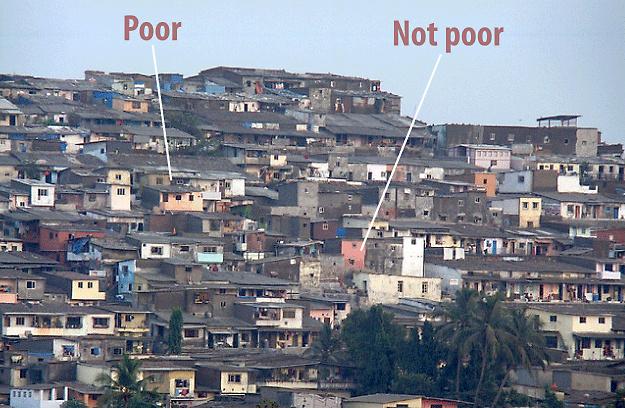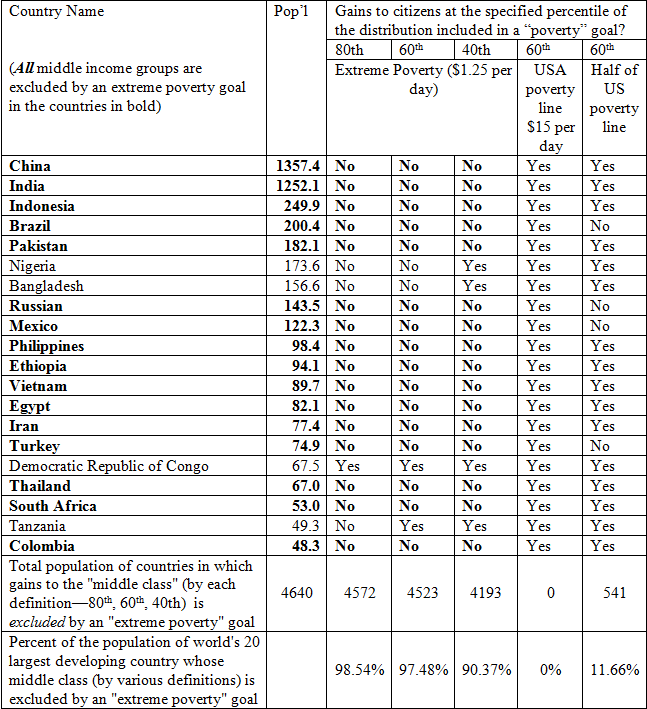“Dollar a day” poverty morphed from a technical curiosity that interests at most a few dozen technocrats to the first of the Millennium Development Goals. It is now one of only two corporate goals of the World Bank (in spite of its obvious inconsistency with the World Bank’s own Articles of Agreement). And , according to a recent (August 18, 2014) missive from Rajiv Shah, the head of USAID “political momentum” is “build[ing] to make the end of extreme poverty central to the post-2015 Development Agenda.”
The last statement is important because it emphasizes that:
- the attempt is to make “extreme poverty” central to the development agenda (not just one goal among many) and,
- making this a central development goal is a political act.
But the global politics of making “eliminating extreme poverty” a central goal of the post-2015 agenda is curious as it eliminates as a central concern gains accruing to the center of the income distribution (or “middle class”) of nearly every large developing country.

Take the top 20 most populous developing countries, which cumulatively have 4.6 billion people. Ask: “Would income gains to their 40th, 60th, or 80th percentile citizen count towards a development agenda centered on a goal of eradicating extreme poverty?
For 16 of the 20 countries (accounting for 4.2 billion people) gains even to their 40th percentile citizens — people poorer than the median — would not count as development progress in eliminating extreme poverty. All of their middle class is excluded.
The 40th percentile person in Ethiopia consumes $1.44 a day (compared to say, $30 a day for the bottom income quintile in the USA) and hence is “too rich” for “extreme poverty” to care about them — as is the 40th percentile person in Pakistan, India, and Vietnam.
The person at the 80th percentile (which is still solidly “middle class” by any definition) is excluded by an “extreme poverty” goal in every country but the Democratic Republic of the Congo. How about the 80th percentile of Tanzania consuming $1.60? Too rich. Nigeria at $2.10? Too rich. Bangladesh at $2.10? Too rich.
There are equally reasonable alternative definitions of global poverty. Instead of using the poverty line of the poorest countries to set a penurious poverty line (its only justification), one could adopt the poverty line of rich countries as a global aspiration. The US poverty line in 2005 was roughly $15 dollars a day.[1] At that poverty line the income gains of the 60th percentile of all 20 countries are included in a global poverty goal. Even at a poverty line of half of the US poverty line ($7.50) the 60th percentile of only Brazil, Russia, Mexico and Turkey (all quite prosperous countries, which cumulatively have a population of 541 million) are excluded from counting as progress in global poverty.
Or, course, some mix: “center” the development agenda on reducing global poverty (high standard), country poverty at country standards (between high and low standards), and eliminating extreme poverty (low standard).
Table 1: An “extreme poverty” goal is extremely exclusionary—gains to the middle income groups in nearly every country in the world are not included as progress by a goal of eradicating extreme poverty

There are three good reasons why gains to those between the 40th and 80th percentile of the income/consumption distribution need to be central to a global development agenda.
First, there is at least a rhetorical consensus on two points: one, that aid effectiveness requires “country ownership,”[2] and two, governments should reflect the wishes of their citizens (some would simplify this to “democracy”). The combination of those two strongly suggests a global development agenda should strongly appeal to the median citizen of developing countries. How can a democratically elected government be expected to “own” a global development agenda centered on a goal that excludes their middle class? While all democratic rich countries have programs and policies to benefit their own “poor” (who are typically at levels of consumption ten times higher than “extreme poverty”) their agenda is not “centered” on just that, but rather on policies that promote the general well-being of all citizens.
Second, the consumption of the median person in developing countries is itself a good development target (Birdsall and Meyer 2014). Their data show that, compared to even the poorest in rich countries, the median in developing countries have very low consumption. The consumption of the poorest income quintile in the USA is 15 times higher than the median person in India, Pakistan, Bangladesh, or Nigeria and almost 10 times higher than even the median person in “middle income” countries like Egypt or China. No one in US politics claims the consumption of the US median household at $39 dollars a day is “too rich” to merit concern.
Third, many have argued that having a functional and prospering “middle class” is instrumentally essential to development and functioning governance and hence benefitting the poor (e.g., Easterly 2000). Given the central role that “good governance” and “building institutions” has acquired in development discourse, try to imagine a successful strategy for strengthening governance or institutions that deliberately excluded the middle class.
How exactly does one build “political momentum” to center a global development agenda on a goal that is not the center of the development agenda of any major developing country? And why? That is for part II.
[1] Poverty lines in the USA are defined in income, not consumption terms, which accounts for why consumption expenditures per person is much higher than the poverty line.
[2] The 2008 Accra Agenda for Action names three areas for improving implementation of the Paris Declaration and its first goals is: Countries have more say over their development processes through wider participation in development policy formulation, stronger leadership on aid co-ordination and more use of country systems for aid delivery.
Disclaimer
CGD blog posts reflect the views of the authors, drawing on prior research and experience in their areas of expertise. CGD is a nonpartisan, independent organization and does not take institutional positions.





